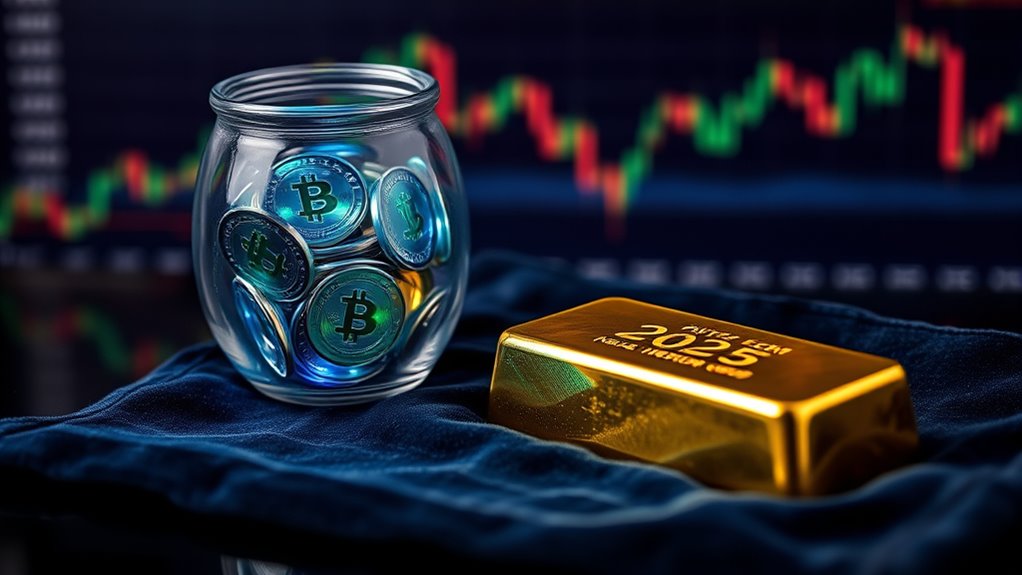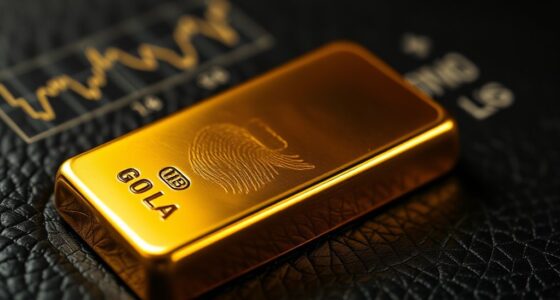In 2025, choosing between gold and cryptocurrency for your IRA depends on your risk tolerance. Gold offers stability, proven longevity, and minimal digital vulnerabilities, making it ideal for conservative investors. Crypto, like Bitcoin, provides high growth potential but comes with significant volatility and security concerns. Balancing both can help you maximize growth while managing risk. To decide the best fit for your goals, you’ll want to evaluate your investment timeline and comfort with digital assets. Keep exploring to learn more.
Key Takeaways
- Gold offers stability and long-term preservation, ideal for conservative investors seeking lower risk in their IRA.
- Cryptocurrency provides high growth potential with significant volatility, appealing to risk-tolerant investors aiming for higher returns.
- Gold’s tangible nature minimizes digital security risks, while crypto’s digital storage requires robust cybersecurity measures.
- 24/7 crypto markets enable continuous trading, unlike gold’s traditional, longer transaction processes.
- Diversifying with both assets can balance risk and growth, aligning with varied investment goals for 2025.

When deciding between gold and cryptocurrency for your IRA, understanding their key differences can help you make an informed choice. Gold has a long history as a stable store of value, offering reliability and less price volatility. It’s been used as an inflation hedge for over 2,000 years, making it a trusted option for conservative investors seeking long-term security. Bitcoin, on the other hand, has delivered extraordinary returns since 2009, often outperforming gold in recent years. However, that growth comes with high volatility, with prices capable of rapid and large swings. If you’re looking for high growth potential, Bitcoin might appeal, but it also introduces higher risk.
Gold offers stability and long-term security, while Bitcoin provides high growth but with greater volatility and risk.
Your risk profile plays a significant role here. Bitcoin is considered much riskier due to its reliance on market sentiment, limited lifespan, and the absence of intrinsic backing. Its value depends heavily on buyer willingness, and digital assets are vulnerable to hacking, theft, and digital security breaches. Gold, being tangible, carries minimal counterparty risk. You own it outright, and it’s not susceptible to hacking or digital theft. Physical gold stored in an IRA must be kept in IRS-approved depositories, which adds logistics but ensures security. Cryptocurrency in an IRA is stored electronically in insured digital wallets, providing a different kind of security. Many crypto IRAs also offer FDIC insurance on uninvested cash, adding some safety net, but they depend heavily on technological safeguards.
Storage considerations differ greatly. Gold requires physical storage, which involves logistics, insurance, and custody arrangements. You need to trust the depository’s security. Cryptocurrencies are stored digitally, demanding robust cybersecurity measures and technological infrastructure. While digital wallets can be insured and protected, they’re still vulnerable to hacking if not secured properly. Liquidity is another factor. Bitcoin IRAs offer liquidity in digital form, allowing you to withdraw and use your holdings as cryptocurrency once eligible. Gold IRAs generally involve longer transaction times, as physical assets must be sold and transferred, which can delay access to funds. Crypto markets operate 24/7, providing continuous trading opportunities, whereas gold markets follow traditional hours with more established settlement procedures. Additionally, the diversification benefits of combining both assets can help mitigate overall investment risk.
Tax considerations also influence your decision. Both gold and crypto IRAs benefit from tax advantages and have contribution limits—$7,000 for 2025. Traditional IRAs allow tax deductions on contributions, but withdrawals are taxed. Roth IRAs let you contribute after-tax dollars, with tax-free withdrawals, which could be advantageous if you expect higher future taxes. Crypto IRAs can include direct cryptocurrency holdings, offering flexibility, whereas traditional IRAs might only support crypto-backed funds like ETFs. Your preference for direct ownership versus fund investment will shape your choice.
Ultimately, your comfort with risk, investment horizon, and liquidity needs determine whether gold or crypto fits best in your IRA. Gold provides stability and proven longevity, while Bitcoin offers high growth potential with significant volatility. Carefully weigh these factors to align your IRA investments with your financial goals for 2025.
Frequently Asked Questions
How Do Gold and Crypto IRA Investments Compare in Tax Benefits?
When comparing tax benefits, both gold and crypto IRAs offer tax-deferred growth, meaning you won’t pay taxes on gains until withdrawal. Gold is taxed at 28% if sold outside an IRA, but within the IRA, gains are deferred. Cryptocurrencies are taxed as property, with capital gains rates applying. Overall, both can help you grow investments efficiently, but your choice depends on your tax strategy and long-term goals.
What Are the Liquidity Differences Between Gold and Crypto IRAS?
You’ll notice that crypto IRAs offer superior liquidity, with 24/7 trading and near-instant transactions, allowing you to sell or buy quickly. Gold IRAs, especially physical gold, are less flexible, often requiring more time to liquidate due to dealer delays, storage, and premiums. ETFs and futures improve gold liquidity, but selling physical gold can take longer and involve higher costs, making crypto assets more accessible for quick trades.
Are There Specific Regulations Affecting Gold Versus Crypto IRAS?
When comparing regulations affecting gold and crypto IRAs, you need to understand their distinct rules. Gold IRAs require IRS-approved custodians, approved physical forms, and secure storage in designated depositories. Crypto IRAs demand self-directed custodians, digital wallets, and strict compliance with digital security, AML, and exchange regulations. Both involve specific rules for storage, transactions, and reporting, but crypto IRAs face additional complexities due to their digital nature and evolving regulatory landscape.
How Does Market Volatility Impact Each Asset Class in IRAS?
Market volatility affects each asset class differently in IRAs. You’ll find gold tends to remain stable during economic shifts, acting as a safe haven, with less dramatic price swings. Cryptocurrencies, however, can fluctuate wildly, offering opportunities for short-term gains but increasing your risk. If you’re risk-averse, you might prefer gold’s stability, but if you’re comfortable with uncertainty, crypto’s volatility could boost your portfolio’s growth potential.
What Are the Best Strategies for Diversifying Within a Gold or Crypto IRA?
You should diversify within your IRA by including various precious metals like gold, silver, platinum, and palladium, aiming for about 10–15% of your portfolio. For crypto, spread investments across multiple cryptocurrencies, stablecoins, and blockchain-based assets to manage volatility. Partner with trusted custodians, choose IRS-approved physical and digital assets, and rebalance periodically. This approach helps you reduce risks, balance growth, and better protect your retirement savings against market fluctuations.
Conclusion
So, as you weigh gold’s stability against crypto’s wild swings in your IRA, remember this ironic truth: the safest option might just be embracing the unpredictable. While gold promises security, it could leave you wishing for more growth. Crypto, though risky, offers excitement and potential. In the end, perhaps the real risk isn’t which asset you choose, but trusting that one safe choice will secure your future—because sometimes, the biggest risk is playing it too safe.









